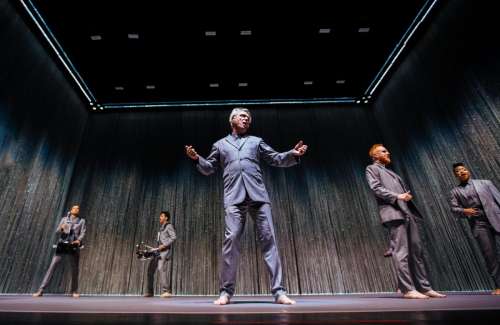David Byrne … forgive us … burns down the House on Memorial Day at the Hult
Via Eugene Weekly

Photo by Todd Cooper
By William Kennedy
The stage is empty and slate grey. A single spotlight highlights a human brain on a table. Holding the brain in his hands, David Byrne, barefoot and dressed in an also slate grey suit sings “Here” from his latest American Utopia.
He presents the brain to the audience, explaining “Here is an area of great confusion / Here is a section that’s extremely precise.”

Photo by Todd Cooper
In my preview of the Byrne show, I said the singer’s solo work has a tendency to get a little too up in his head for my tastes: forgetting the visceral for the cerebral, a balance better struck by his legendary former band the Talking Heads.
“So is this bit with the brain some kind of mea culpa?” I think to myself as I sit among the sold-out Hult Center crowd.
Apology accepted, Dave.
It doesn’t take long for classic Heads tunes to show up.
First, “I Zimbra” off the Heads’ 1979 classic Fear of Music. What follows is one of the most brilliantly conceived and executed rock shows I’ve ever seen.
Throughout, there’s a synthesis of Byrne’s voracious interest in global rhythms and song structures alongside new wave experimentation and Byrne’s trademark postmodern anxiety.
There are plenty of Heads tunes: “Burning Down the House” and “Home.” The crowd erupts for the immortal Talking Heads mega-hit “Once in a Lifetime.” Byrne attacking the song like he’s shot out of a cannon.
Overall, the American Utopia tour is an inspired deconstruction of the traditional, drummer here, lead guitar there, singer does this, rock show presentation. It’s about space, both external and internal, theatrically maximizing the width and depth of the stage, the inner workings of Byrne’s own mental machinery and the acute uneasiness of our current American moment.
There’s a kind of choreography to the show. One minute, Byrne, his backup singers and the instrumentalists form minimal, geometric patterns on the stage, and the next they circle and weave, Carnivale style.

Photo by Todd Cooper
At any given time, you see up to 12 players on the stage, with plenty of visual punchlines to the movement. Byrne and his backup singers dance to Utopia track “I Dance Like This” a little like stiff, middle-aged accountants practicing tai chi in Central Park.
Throughout, Byrne’s newer stuff holds up well, particularly for the staging concept. Byrne faces stage left while singing to a glowing blue light just off stage. “I used to think that I should watch TV / I used to think that it was good for me,” from the song “I Should Watch TV,” off Love this Giant, Byrne’s 2012 collaboration with St. Vincent.
As Byrne continues his tale of modern media overload, the band closes in on him oppressively before Byrne finally disappears into the curtain, defeated.
Every time I see a rock show at the Hult, I find what seems to be most unprepared-for-rock-music-revelry staff since Michelle Wolff did the White House Correspondents Dinner. But it’s a gem of a hall in the center of our town, and the mixed crowd, ranging from evening wear to festival-kid extravagance, was genial — perfect for Byrne’s high-concept performance.
In the end, Byrne’s built an entire career making art out of his own discomfort, a celebration of the awkward. The American Utopia tour, however, finds Byrne loose, inspired and happy. “Every day is a miracle,” Byrne sings on the Utopia track of the same name. Thanks for the reminder, old friend. You’ve given us all a small little miracle tonight.